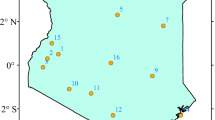Abstract
A multiscale-modeling framework for daily rainfall is considered and diagnostic results are presented for an application to the winter season in Northwest India. The daily rainfall process is considered to follow a hidden Markov model (HMM), with the hidden states assumed to be an unknown random function of slowly varying climatic modulation of the winter jet stream and moisture transport dynamics. The data used are from 14 stations over Satluj River basin in winter (December–January–February–March). The period considered is 1977/78–2005/06. The HMM identifies four discrete weather states, which are used to describe daily rainfall variability over study region. Each state was found to be associated with a distinct atmospheric circulation pattern, with the driest and drier states, State 1 and 2 respectively, characterized by a lack of synoptic wave activity. In contrast, the wetter and wettest states, States 3 and 4 respectively, are characterized by a zonally oriented wave train extending across Eurasia between 20N and 40N, identified with ‘western disturbances’ (WD). The occurrence of State 4 is strongly conditioned by the El Nino and Indian Ocean Dipole (IOD) phenomena in winter, which is demonstrated using large-scale correlation maps based on mean sea level pressure and sea surface temperature. This suggests that there is a tendency of higher frequency of the wet days and intense WD activities in winter during El Nino and positive IOD years. These findings, derived from daily rainfall station records, help clarify the sequence of Northern Hemisphere mid-latitude storms bringing winter rainfall over Northwest India, and their association with potentially predictable low frequency modes on seasonal time scales and longer.













Similar content being viewed by others
References
Ashok K, Guan Z, Yamagata T (2001) Impact of the Indian Ocean dipole on the relationship between the Indian monsoon rainfall and ENSO. Geophys Res Lett 28(23):4499–4502
Das PK (1986) Monsoons. World Meteorological Organization, Fifth WMO lecture, WMO No. 613, Geneva
Dee DP, Uppala SM, Simmons AJ et al (2011) The ERA-interim reanalysis: configuration and performance of the data assimilation system. Quat J R Meteorol Soc 137:553–597. doi:10.1002/qj.828
Dimri AP (2013a) Intraseasonal oscillation associated with Indian winter monsoon. J Geophys Res Atmos 118:1–10. doi:10.1002/jgrd.50144
Dimri AP (2013b) Interannual variability of Indian winter monsoon over the Western Himalayas. Global Planet Change 106:35–50. doi:10.1016/j.gloplacha.2013.03.002
Dimri AP, Mohanty UC (2009) Simulation of mesoscale features associated with intense western disturbances over western Himalayas. Meteorol Appl 16:289–308
Forney GD Jr (1978) The Viterbi algorithm. In: Proceedings of the IEEE, pp 267–278
Gadgil S (2003) The Indian monsoon and its variability. Annu Rev Earth Planet Sci 31(1):429–467
Hoskins BJ, McIntyre ME, Robertson AW (1985) On the use and significance of isentropic potential vorticity maps. Quat J R Meteorol Soc 111:877–946
Hughes JP, Guttorp P (1994) A class of stochastic models for relating synoptic atmospheric patterns to local hydrologic phenomenon. Water Resour Res 30:1535–1546
Kalnay EM, Kanamitsu R, Kistler W et al (1996) The NCEP/NCAR 40-year reanalysis project. Bull Am Meteorol Soc 77(3):437–471
Kirshner S (2005) Modeling of multivariate time series using hidden Markov models, PhD Thesis, Columbia University
Kumar KK, Rajagopalan B, Cane MA (1999) On the weakening relationship between the Indian monsoon and ENSO. Science 284(5423):2156–2159
Kumar KK, Rajagopalan B, Hoerling M, Bates G, Cane M (2006) Unraveling the mystery of Indian monsoon failure during El Niño. Science 314(5796):115–119
Pal I, Lall U, Robertson AW, Cane MA, Bansal R (2013a) Predictability of Western Himalayan river flow: melt seasonal inflow into Bhakra reservoir in Northern India. Hydrol Earth Syst Sci 17:2131–2146. doi:10.5194/hess-17-2131-2013
Pal I, Lall U, Robertson AW, Cane MA, Bansal R (2013b) Diagnostics of Western Himalayan Satluj river flow: warm season (MAM/JJAS) inflow into Bhakra dam in India. J Hydrol 478:132–147
Rao GN (1999) Variations of the SO relationship with summer and winter monsoon rainfall over India: 1872–1993. J Clim 12:3486–3495
Robertson AW, Kirshner S, Smyth P (2004) Downscaling of daily rainfall occurrence over Northeast Brazil using a Hidden Markov Model. J Clim 17:4407–4424
Robertson AW, Kirshner S, Smyth P, Charles SP, Bates BC (2006) Subseasonal-to-interdecadal variability of the Australian monsoon over North Queensland. Quat J R Meteorol Soc 132:519–542
Robertson AW, Moron V, Swarinoto Y (2009) Seasonal predictability of daily rainfall statistics over Indramayu district, Indonesia. Int J Climatol 29:1449–1462
Schwarz GE (1978) Estimating the dimension of a model. Ann Stat 6(2):461–464. doi:10.1214/aos/1176344136. MR 468014
Sen Roy S (2006) The impacts of ENSO, PDO, and Local SSTs on winter precipitation in India. Phys Geogr 27(5):464–474
Shukla J (1975) Effect of Arabian Sea surface temperature anomaly on Indian summer monsoon: a numerical experiment with GFDL model. J Atmos Sci 32:503–511
Vernekar AD, Zhou J, Shukla J (1995) The effect of Eurasian snow cover on the Indian monsoon. J Clim 8(2):248–266
Washington W, Chervin R, Rao GV (1977) Effects of a variety of Indian Ocean surface temperature anomaly patterns on the summer monsoon circulation: experiments with the NCAR GCM. Pure Appl Geophys 115:1335–1356
Yadav RK, Yoo JH, Kucharski F, Abid MA (2010) Why is ENSO influencing northwest India winter precipitation in recent decades? J Clim 23:1979–1993
Yadav RK, Rupa Kumar K, Rajeevan M (2012) Characteristic features of winter precipitation and its variability over northwest India. J Earth Syst Sci 121(3):6111–6623
Acknowledgments
The authors acknowledge Rajeev Bansal, and the Bhakra Beas Management Board of India for sharing the rainfall datasets. AWR was supported by DOE’s EaSM Grant DE-SC0006616 and by ONR’s MURI Grant N00014-12-1-0911.
Author information
Authors and Affiliations
Corresponding author
Rights and permissions
About this article
Cite this article
Pal, I., Robertson, A.W., Lall, U. et al. Modeling winter rainfall in Northwest India using a hidden Markov model: understanding occurrence of different states and their dynamical connections. Clim Dyn 44, 1003–1015 (2015). https://doi.org/10.1007/s00382-014-2178-5
Received:
Accepted:
Published:
Issue Date:
DOI: https://doi.org/10.1007/s00382-014-2178-5




